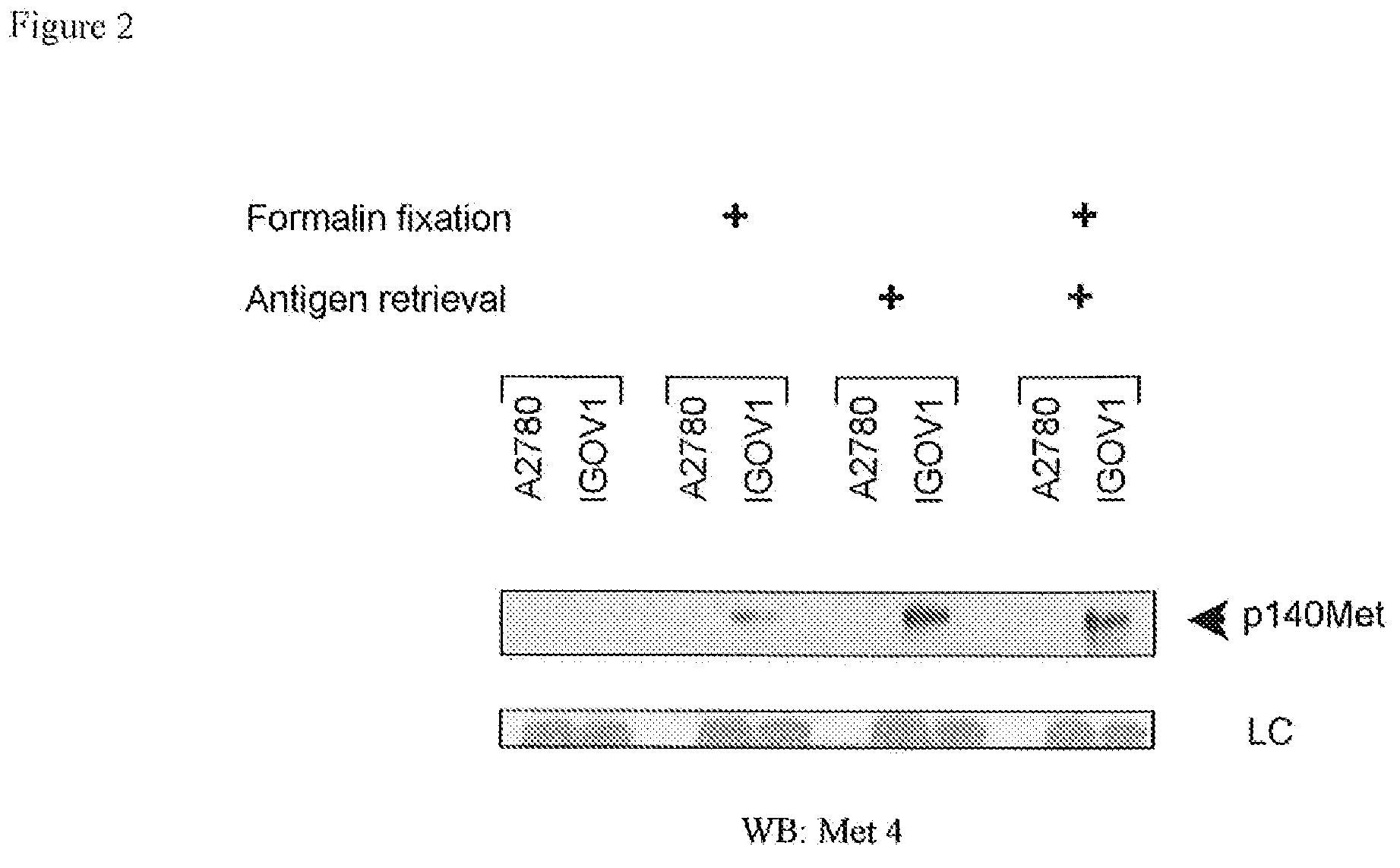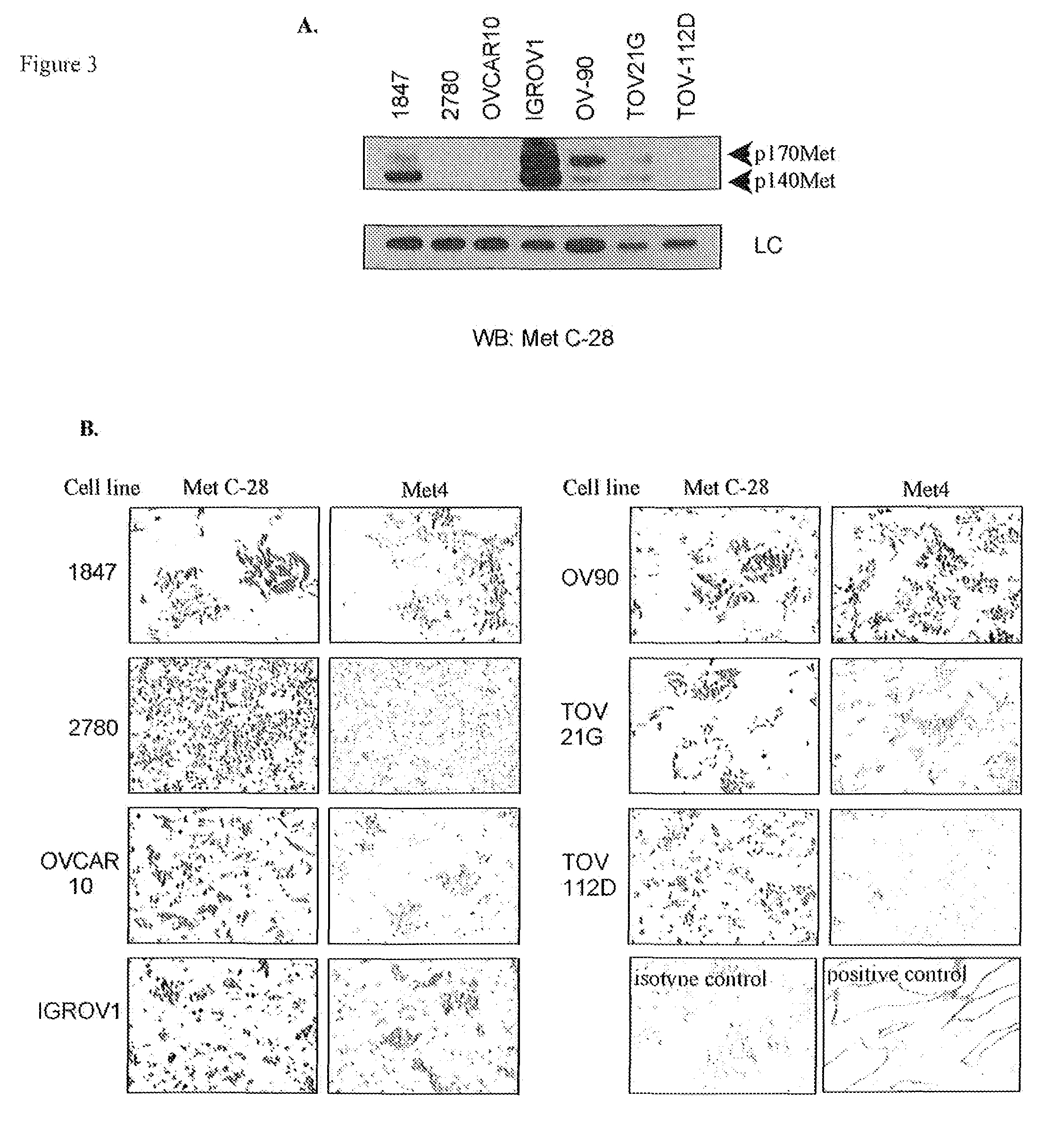Monoclonal antibody which binds cMet (HGFR) in formalin-fixed and paraffin-embedded tissues and related methods
a monoclonal antibody and cmet technology, applied in the field of molecular diagnostics and medicine, can solve the problems of unreliable commercially available met antibodies, unreliability of immunohistochemical studies, and elevated hgf/sf concentrations in the tumor microenvironment, and achieve the effects of improving immunohistochemical results and improving immunohistochemical results
- Summary
- Abstract
- Description
- Claims
- Application Information
AI Technical Summary
Benefits of technology
Problems solved by technology
Method used
Image
Examples
example 1
Materials and Methods for Examples 1-5
[0079]Monoclonal Antibody Generation and Validation:
[0080]Recombinant protein Met 25-567H was prepared by Dr. Eric Xu's lab in Van Andel Institute. Met 25-567H construct (SEQ ID NO. 1, amino acids at positions 25-567) and purified Met 928 protein were from Dr. Ermanno Gheradi's lab in Cambridge Antibody Technology41. Recombinant fusion protein Met-IgG was purchased from R&D systems (Minneapolis, Minn.).
[0081]Mouse monoclonal antibodies against Met were produced by injecting BALB / c mice i.p. with native and denatured (boiling in SDS sample buffer) Met 25-567H in complete Freund's adjuvant, followed by two additional injections with incomplete Freund's adjuvant. After 1 month, a final injection was given i.p. and i.v. without adjuvant. Polyclonal antisera from immunized mice were tested by indirect immunofluorescence with formalin-fixed MKN45 (Met positive) and NIH3T3 (Met negative) cells. Spleen cells were fused with P3X63AF8 / 653 myeloma cells us...
example 2
Development of an Anti-c-Met Monoclonal Antibody for Quantification of c-Met in Formalin-Fixed Tissues
[0095]The limitations of C-28, a polyclonal antibody from Santa Cruz, which has been used to measure Met expression in most in vitro and immunohistochemical studies, motivated our development of a monoclonal antibody (mAb) for measurement of c-Met protein expression in patient cancers for clinical applications, including molecular imaging and immunohistochemistry in formalin-fixed tissues. The immunogen was designed to obtain c-Met antibodies that react with the extracellular domain of the Met receptor, since this provides the most direct measurement to evaluate the abundance of c-Met expression on the cell surface. The resulting mAbs overcome the lot-to-lot variability of C-28 and the nuclear reactivity observed with antibodies that bind the Met cytoplasmic domain.
[0096]As a final screen to identify monoclonal antibodies that specifically bind the Met receptor in formalin-fixed and...
example 3
Specificity of Met4 for Reactivity with c-Met in Formalin-Fixed Cells
[0099]To confirm the reactivity of Met4 with the Met receptor protein, a Western blot was probed with Met4. By recapitulating conditions of formalin-fixation in tissues, Western blot membranes were treated with 10% formalin and underwent the same type of antigen retrieval as had been applied to tissue sections. Met4 did not react with denatured Met receptor protein in IGROV1 ovarian cancer cells, which express a large amount of c-Met. Formalin fixation or boiling of the membrane in antigen retrieval buffer increased Met4 binding to c-Met and revealed a 140 kDa c-Met band (FIG. 2). Met4 reacted nonspecifically with lower molecular weight bands, some of which also appeared in the Met receptor negative A2780 cell line. The immunofluorescence and Western blotting results demonstrate that Met4 binds to a specific epitope on Met that is sensitive to denaturation and that is re-established by formalin-fixation or antigen ...
PUM
 Login to View More
Login to View More Abstract
Description
Claims
Application Information
 Login to View More
Login to View More - R&D
- Intellectual Property
- Life Sciences
- Materials
- Tech Scout
- Unparalleled Data Quality
- Higher Quality Content
- 60% Fewer Hallucinations
Browse by: Latest US Patents, China's latest patents, Technical Efficacy Thesaurus, Application Domain, Technology Topic, Popular Technical Reports.
© 2025 PatSnap. All rights reserved.Legal|Privacy policy|Modern Slavery Act Transparency Statement|Sitemap|About US| Contact US: help@patsnap.com



